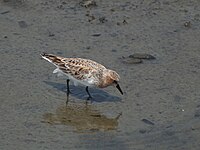40:
70:
331:
47:
131:– shallow, semi-permanent, brackish lake which is divided into a northern basin measuring six by six kilometres (3.7 by 3.7 mi) and a southern basin measuring nine by four point five kilometres (5.6 by 2.8 mi) with a maximum water depth of about one metre (3.3 ft);
117:. It includes the following lakes listed in order from north to south - Hawdon, Robe, Eliza, St Clair and George, and the area extending for a distance of one kilometre (0.62 mi) inland from each in order to include habitat used by
152:– about thirteen by eight kilometres (8.1 by 5.0 mi) with maximum depth of 3.5 metres (11 feet); naturally hypersaline but functions as an estuary with an outlet to the sea.
292:
375:
39:
394:
60:
404:
368:
361:
242:
214:
230:
28:
218:
226:
114:
90:
399:
81:
comprises an area of 374 square kilometres (144 square miles) covering a series of five coastal lakes in the
222:
170:
162:
121:
118:
110:
182:
174:
106:
190:
186:
69:
17:
166:
338:
210:
86:
82:
140:– hypersaline coastal lake with maximum depth of 1.4 metres (4 feet 7 inches);
345:
388:
271:
330:
194:
178:
198:
307:
294:
341:
165:
as an IBA because it regularly supports over 1% of the world populations of
89:. They are the most important of a string of regional lakes occupying
209:
While the IBA has no statutory status, it does overlap the following
193:. The adjacent beaches and offshore islets, from Cowrtie Island to
134:
Lake Robe – 406 hectares (1,000 acres) much smaller than Lake Hawdon
68:
146:– 189 hectares (470 acres) similar to Lake Eliza but more saline
94:
349:
181:. It also provides habitat for orange-bellied parrots,
272:"Important Bird Areas factsheet: Lake Hawdon System"
73:The IBA is an important site for red-necked stints
46:
369:
8:
376:
362:
395:Important Bird Areas of South Australia
254:
79:Lake Hawdon System Important Bird Area
266:
264:
262:
260:
258:
161:The wetland system was identified by
7:
327:
325:
124:. Characteristics of the lakes are:
25:
157:Criteria for nomination as an IBA
329:
243:List of birds of South Australia
109:(IBA) lies between the towns of
45:
38:
405:South Australia geography stubs
227:Lake St Clair Conservation Park
18:Lake St Clair (South Australia)
274:. BirdLife International. 2017
93:between modern and historical
1:
197:, sometimes support breeding
348:. You can help Knowledge by
231:Little Dip Conservation Park
219:Beachport Conservation Park
215:South Australian government
64:Location in South Australia
421:
324:
205:Associated protected areas
26:
171:sharp-tailed sandpipers
53:Lake Hawdon System IBA
308:37.27611°S 139.92639°E
223:Lake Robe Game Reserve
163:BirdLife International
122:orange-bellied parrots
74:
183:Australasian bitterns
175:double-banded plovers
119:critically endangered
72:
313:-37.27611; 139.92639
61:class=notpageimage|
27:For other uses, see
304: /
191:striated fieldwrens
187:rufous bristlebirds
107:Important Bird Area
75:
357:
356:
16:(Redirected from
412:
378:
371:
364:
333:
326:
319:
318:
316:
315:
314:
309:
305:
302:
301:
300:
297:
284:
283:
281:
279:
268:
213:declared by the
167:red-necked stint
49:
48:
42:
21:
420:
419:
415:
414:
413:
411:
410:
409:
400:Limestone Coast
385:
384:
383:
382:
339:South Australia
322:
312:
310:
306:
303:
298:
295:
293:
291:
290:
288:
287:
277:
275:
270:
269:
256:
251:
239:
211:protected areas
207:
169:, and often of
159:
103:
91:swale corridors
87:South Australia
83:Limestone Coast
67:
66:
65:
63:
57:
56:
55:
54:
50:
32:
23:
22:
15:
12:
11:
5:
418:
416:
408:
407:
402:
397:
387:
386:
381:
380:
373:
366:
358:
355:
354:
334:
286:
285:
253:
252:
250:
247:
246:
245:
238:
235:
206:
203:
158:
155:
154:
153:
147:
141:
135:
132:
102:
99:
59:
58:
52:
51:
44:
43:
37:
36:
35:
24:
14:
13:
10:
9:
6:
4:
3:
2:
417:
406:
403:
401:
398:
396:
393:
392:
390:
379:
374:
372:
367:
365:
360:
359:
353:
351:
347:
344:article is a
343:
340:
335:
332:
328:
323:
320:
317:
273:
267:
265:
263:
261:
259:
255:
248:
244:
241:
240:
236:
234:
232:
228:
224:
220:
216:
212:
204:
202:
200:
196:
192:
188:
184:
180:
179:banded stilts
176:
172:
168:
164:
156:
151:
148:
145:
144:Lake St Clair
142:
139:
136:
133:
130:
127:
126:
125:
123:
120:
116:
112:
108:
100:
98:
96:
92:
88:
84:
80:
71:
62:
41:
34:
30:
19:
350:expanding it
336:
321:
289:
276:. Retrieved
208:
195:Baudin Rocks
160:
149:
143:
137:
128:
104:
78:
76:
33:
311: /
299:139°55′35″E
278:15 December
199:fairy terns
150:Lake George
129:Lake Hawdon
101:Description
29:Lake Hawdon
389:Categories
296:37°16′34″S
249:References
138:Lake Eliza
95:sand dunes
342:geography
115:Beachport
237:See also
337:This
346:stub
280:2017
229:and
189:and
177:and
113:and
111:Robe
105:The
77:The
85:of
391::
257:^
233:.
225:,
221:,
217::
201:.
185:,
173:,
97:.
377:e
370:t
363:v
352:.
282:.
31:.
20:)
Text is available under the Creative Commons Attribution-ShareAlike License. Additional terms may apply.

